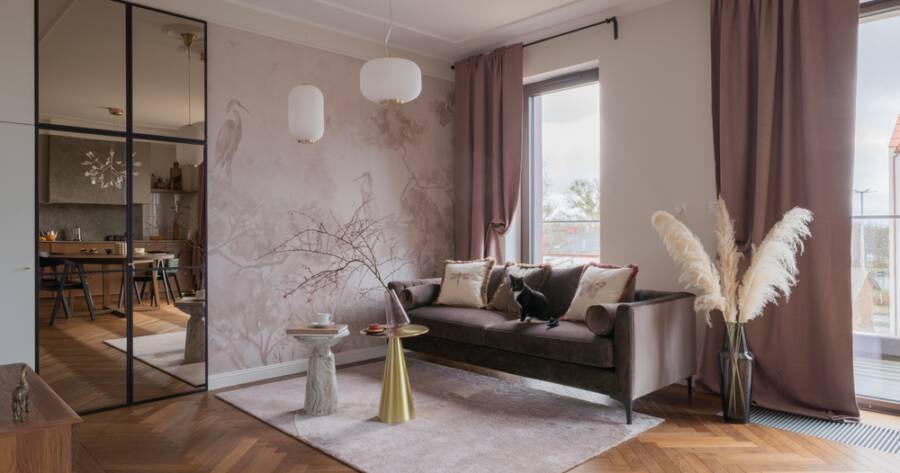Making your home feel more spacious doesn’t always require knocking down walls or undergoing renovations. Thoughtful design choices can create an airy, open atmosphere, even in smaller spaces. From strategic furniture placement to clever use of color, transforming your home’s layout can dramatically change the way it feels. Simple changes like adding mirrors or using floor-to-ceiling drapes can make a room appear larger and more inviting. Finding ways to maximize space enhances both comfort and style.
Embrace Vertical Space with Floor-to-Ceiling Drapes
One of the easiest ways to make a room feel taller and more open is by using floor-to-ceiling drapes. Hanging curtains high above the window frame draws the eye upward, creating the illusion of height. Opt for light, airy fabrics like sheer or linen to maintain a soft, open look. Neutral tones work well, as they blend seamlessly with most decor styles. Using a curtain rod that extends beyond the window frame also lets in more natural light when the drapes are open.
For small rooms, choosing drapes that match the wall color minimizes visual breaks, keeping the space cohesive. If you prefer patterns, subtle vertical stripes can enhance the illusion of height. Floor-to-ceiling drapes not only make your space feel taller but also add an elegant touch to any room. Investing in quality curtain hardware ensures a polished, professional look that enhances your home’s overall aesthetic.
Use Mirrors to Reflect Light and Space
Mirrors are powerful tools for making a space feel larger. Strategically placing mirrors opposite windows reflects natural light, brightening the room and giving it a more open feel. A large, framed mirror positioned above a console or sofa creates a focal point while enhancing the perception of depth. Grouping smaller mirrors in a pattern can also add visual interest without overwhelming the space.
For narrow hallways or compact living areas, consider using mirrored furniture or wall panels to subtly increase brightness. Mirrored surfaces can make even the darkest corners feel more inviting. Leaning a full-length mirror against a wall creates verticality, while mirrored backsplashes in kitchens reflect light, keeping the area feeling airy. Incorporating mirrors thoughtfully helps make your home feel more expansive and welcoming.
Define Areas with Rugs: Create Zones Without Walls
Using area rugs to define spaces helps create a sense of order and makes each part of your home feel purposeful. In open-concept living areas, a large rug under the seating arrangement visually separates the lounge space from the dining area. Choosing a patterned rug can add texture and break up monotony, while a solid color rug keeps the room feeling unified. Layering rugs of different sizes and textures adds depth without cluttering the floor.
For bedrooms, placing a soft, plush rug under the bed that extends beyond the sides creates a cozy, anchored feel. In home offices, a small rug under the desk visually sets the workspace apart. Matching the rug’s color palette to the room’s decor maintains harmony. Thoughtfully chosen rugs not only make rooms feel more spacious but also introduce warmth and personality.
Make Smart Use of Color: Light and Neutral Tones
Color can dramatically impact how spacious a room feels. Light and neutral shades, like soft grays, creams, and whites, reflect more light, giving the illusion of a larger area. Painting walls, ceilings, and trim in similar tones eliminates visual breaks, allowing the eye to travel seamlessly. Creating a monochromatic palette makes the space feel cohesive and less confined.
Accenting with pops of color in accessories, such as throw pillows or artwork, adds personality without overwhelming the room. If you prefer darker shades, using them on lower surfaces, like furniture or area rugs, grounds the space while keeping the walls light. Incorporating subtle variations of one color throughout the room maintains a spacious, airy feel without sacrificing style.
Choose Multifunctional Furniture: Optimize Space Usage
Investing in furniture that serves multiple purposes is key to making a small space feel more open. A sofa bed, storage ottoman, or fold-out dining table can adapt to various needs without overcrowding the room. Choosing pieces with slim profiles and elevated legs exposes more floor area, making the space appear less dense. Floating shelves and wall-mounted desks keep surfaces clear while maximizing vertical space.
Modular furniture, like stackable chairs or nesting tables, can be rearranged easily for different functions. Opt for built-in storage wherever possible, such as beds with drawers underneath or wall units with hidden compartments. Keeping the layout flexible allows you to adapt your living space as needed while maintaining an uncluttered, spacious atmosphere.
Keep Clutter to a Minimum: Create a Clean, Open Look
Clutter makes even the most spacious rooms feel cramped. Adopting a minimalist approach helps maintain a clean, organized look. Start by decluttering surfaces like countertops, desks, and coffee tables. Use decorative baskets or storage boxes to keep small items out of sight. Implementing a “one in, one out” rule for new purchases helps prevent clutter from building up over time.
Opt for furniture with built-in storage to hide everyday essentials. Floating shelves can display curated collections without occupying valuable floor space. Keeping decor simple and purposeful avoids visual overwhelm. Regularly tidying up not only keeps your space looking larger but also promotes a sense of calm and relaxation. Maintaining a clutter-free environment contributes significantly to an open, airy feel.
Creating a Spacious Home You Love
Transforming your home to feel more spacious doesn’t require major renovations—just thoughtful adjustments that enhance openness and comfort. From choosing the right drapes to incorporating mirrors and multifunctional furniture, each small change contributes to a more airy and inviting environment.
Embracing light, neutral colors, and keeping clutter at bay further amplifies the sense of space. Whether your home is large or small, creating a layout that feels spacious makes everyday living more enjoyable.

